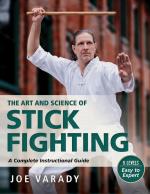Stick fighting, both for self-defense and sport, has existed for many thousands of years. All across the globe, different cultures have shaped the way stick fighting was practiced, resulting in many different styles. Each of these styles has its particular strengths and weaknesses, and each of these styles has undoubtedly produced many capable and formidable fighters.
As mankind learned to work metal and make swords, stick fighting became sword fighting. Some blades, like the short sword, were made exclusively as a tool for killing, while others, like the machete, were more utilitarian in nature. However, swords are both more dangerous and more expensive than sticks in regards to the cost of both weapons and safety equipment. Compared to metal swords, sticks are not only less deadly, but far cheaper and easier to obtain. This advantage has made stick fighting endure as a common alternative to bladed weapons for practicing sword fighting, sport competitions, and self-defense.
Around the World
Western stick fighting traditions from Europe include the Irish shillelagh and French cane. While both evolved from walking sticks, they are very different in nature. The shillelagh is traditionally made from a stout knotty oak or blackthorn stick with a large knob at the top, and it was often used as a club or cudgel. Cudgelling was a type of duel fought with wooden weapons popular in Britain during the Georgian Era (early 1700’s to mid 1800’s). Also known as ‘single stick’, the aim of the competition was to break the skin on the head, face or neck so that blood was drawn. When the crowd saw blood, they would shout ‘A head!’ and an umpire determined if the match was won. Competitors needed to have good endurance as it could take quite some time to hit your opponent hard enough to draw blood.
In France, the cane became a popular weapon when knives and guns were banned in the 1800s. Modern day French cane fighters compete against each other wearing padded suits and fencing masks, as do practitioners of the Portuguese art of Jogo Do Pau.
In South Africa we find the art of Donga, also called Dlala 'Nduku, which translates as “playing sticks.” Participants usually wield two long sticks. One is used as the attacking stick while the other, the defending stick, is used as a shield. Ceremonial matches are full contact, and very little armor is worn. The Trans-Atlantic slave trade brought these traditions to places like Barbados, where “sticklicking” is still actively practiced to this day. African slaves also imported stick fighting to Trinidad, where it developed into a martial sport called Bois. Bois uses thick sticks about four feet long and incorporates drumming and dancing. Don’t let that fool you, however. Matches are full contact and no armor is worn. The fighter who draws first blood is declared the victor.
Asia also has its unique stick fighting traditions. Among them is Japanese Bojutsu, or “stick arts,” which is most famous for its rokushakubo (six-foot staff) but also included instruction in the jo (four-foot staff), hanbo (three-foot stick). In Okinawa, the tambo (short stick) was popular. The Pilipino martial arts of eskrima, kali, and arnis are currently the most popular stick fighting arts and are practiced in nearly every country all around the world. Eskrimadors often fight high-energy full contact bouts with rattan sticks while wearing padded jackets, gloves, and barred helmets.
This list just begins to scratch the surface of the many stick-fighting traditions that can be found all around globally. Each is unique and has its own strengths and weaknesses. But, they have certain commonalities, as well. These common techniques would certainly have different names and would not necessarily be performed exactly the same way, but to get lost in the details would be to not see the forest for the trees. What is important are the universal principles behind these techniques that make them work. These commonalities are the essence of stick fighting, the things that every stick fighter should know, understand, and be able to use. They are the guiding principles that define the Art and Science of Stick Fighting.
Why Learn Stick Fighting?
There are many practical reasons to learn how to fight with sticks. Stick fighting is a healthy, competitive activity that has real world applications. Stick fighting skills are very practical for self-defense, while stick fighting also serves as a sport, offering both entertainment and fitness. It appeals to all types of people, of all ages and ability levels.
During a self-defense situation, it usually helps to possess more power than your opponent. Greater power can be achieved with greater physical size, muscular strength, and fighting experience. Weapons, such as short sticks, can also act as power multipliers. They increase your speed, force, and range, giving one person the ability to fight off much larger, even multiple, opponents. The odds of having your sticks with you to defend yourself are very low; however, your everyday environment contains many similar items the same size as your sticks that can be used as effective, improvised weapons. Objects such as umbrellas, car antennae, curtain rods, plunger handles, walking sticks, baseball bats, or tennis rackets, can be wielded in self-defense like a stick, thereby making it practical to learn how to fight with sticks. Concepts and skills from stick fighting apply to self-defense situations involving knives and empty-handed weaponless defense, as well.
Sport or Self-Defense?
There is an important distinction that needs to be made between self-defense and sport when it comes to stick fighting, and all martial arts for that matter. Sport fighting is meant to be similar to, but certainly not the same as, a self-defense encounter. Sport fighting is governed by clear-cut rules, and the contestants stand and fight in a safe, controlled arena, until a winner is declared.
On the street, your goal is to fight only as long as is necessary to escape to safety. There are no rules of engagement in self-defense except to do whatever is needed to survive, and the arena is never ideal. A serious, unwavering, and focused mindset is critical in self-defense. Sport fighting provides the arena and the time for a fighter to focus on developing fighting skill sets that may help in self-defense. It provides the fighter an experience that develops personal discipline and fosters courage through a voluntary exposure to adversity. It is also a fun, safe way to get into shape, to improve your ability to think on the fly, and to test one’s spirit. It serves many purposes, of which training for self-defense is but one.
There is also an important distinction that needs to be made between a trained stick fighter and a person fighting with a stick. A fighter is called a fighter for a reason, and a trained stick fighter is a breed apart. A trained stick fighter has tremendous speed compared to an untrained stick fighter. Weapons move at a high speed, so training with them improves reaction time. Regular practice with weighted objects like sticks also helps develop overall body strength, coordination, and empty hand speed.
Ask any baseball or tennis coach, and they will tell you that speed is an acquired skill. Rigorous, repetitive training with a stick increases a stick fighter’s ability to wield that stick faster and faster because his body becomes so comfortable moving and hitting with the stick that it requires less and less muscle energy. Untrained fighters, on the other hand, even those with greater raw power, will not be able to wield the stick to their advantage because their bodies will need to rely on muscle energy making their strikes slower and weaker.
Just knowing how to swing a stick and to be able to swing it fast are not enough. Targeting and accuracy are just as important as speed and power, since a strike needs to hit a vulnerable target in order to inflict damage. A trained stick fighter not only knows how to hit with a stick, but knows where to hit for maximum effect. This knowledge and precision is developed with proper training and lots of repetitive practice. An untrained fighter lacks both the targeting and accuracy needed to hit decisively and effectively with the weapon, especially in the heat of the moment, when he is trying to hit with maximum force for maximum effect.
A proper stick fighter’s training regime is progressive, frequent, challenging, and physically strenuous. Stick fighting practice provides cardiovascular exercise and all-around physical fitness. The best stick fighters achieve a high level of physical fitness that a non-trained person usually does not have. The training that a stick fighter endures provides him with the stamina to keep fighting long after an untrained fighter has tired out. Perhaps even more importantly, stick fighting often leads to a lifelong path of health and fitness.
Now go study and practice some more.
The above is an excerpt from The Art and Science of Stick Fighting: A Complete Instructional Guide by Joe Varady, Pub Date March 2020, by YMAA Publication Center, ISBN: 978-1-59439-733-2



